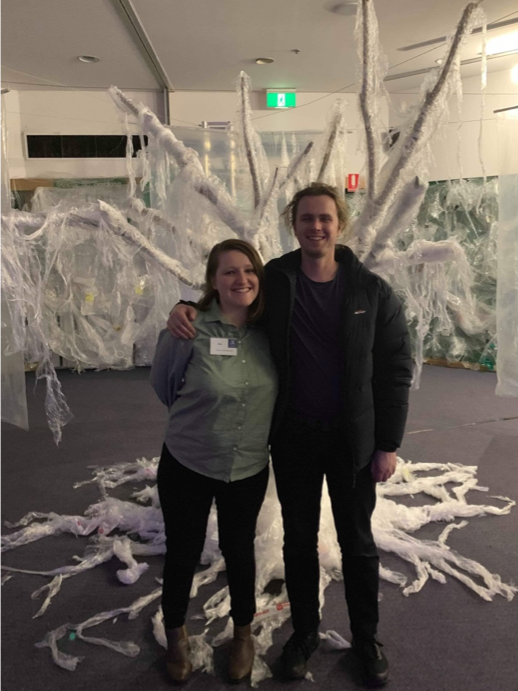“We are the seeds you will plant in plastic; we are your stagnant future”
You walk into the library after-hours. The lights are dim, but you can see; there are people talking, but not loud enough to distract your inner monologue. The bookshelves have been pushed aside and in their place are three projectors shining flickering images on the windows and a path lined with knee-high bags of soft plastic.
You follow the path to a doorway and push aside the plastic curtains hiding the room beyond. The sound outside is muffled as the curtains fall shut behind you. You’re underwater, or so you think, the walls and windows are covered in plastic making the street outside blurry as if you’re looking through water. Plastic seaweed hangs from the ceiling and blue lights are angled to look like sunlight refracting from above. The speaker in the corner plays a ghostly song punctuated by poetic lines. You can’t make out the lines entirely, but you catch the words.
Stagnant, toxic, suffocating, cramped
You stand in the seaweed and feel your breath speed up and shorten. Mild claustrophobia begins to set in. You’re a fish weaving through plastic in search of food, you’re a turtle looking for a clear spot of beach to lay your eggs, you’re a human who uses these plastic products every day.

You leave the seaweed and enter the next room. White plastic covers the walls giving the room a sterile feeling. Your eyes are drawn to the centre where a lone tree stands. It’s the last tree on Earth, its branches are like the bones of a skeleton, and, at first, it looks like it’s covered in strange leaves until you get closer and see they are not leaves, but more plastic strangling the tree.

The plastic covered tree. 
Alex and I at the end of Plastisphere
Around the tree are five screens with people talking to you, or pleading. You can’t quite work out what they’re saying but you catch the same phrases and the same imagery as before. A stagnant future, and cities on the brink of collapse. Who are they? Where are they?

Intergenerational equity was the theme of last weekend. On Friday I attended the Climate Strike in Melbourne. The crowd was massive as people of all ages and all walks of life gathered to tell the leaders of the world that we wanted real action on climate change.
I hate being in crowds. I’m 155cm tall, which puts me at the average under-arm height. I’m also historically literate enough to know that striking has a very low chance of bringing serious change. But I attended anyway for two reasons: first, when my future kids, nieces, nephews, grandkids ask me where I was when the Australian government was failing to address climate change in the late 2010s, I can tell them I was there on the streets. I don’t want to be a bystander to the destruction of their or my own future, which leads to my second much more selfish reason, that climate change will affect me personally.
When I first learnt about climate change at school and when we were taught about intergenerational equity and how future generations will have to deal with the problems caused by rising temperatures due to burning fossil fuels, I saw ‘future generations’ as some abstract concept. I didn’t realise they were talking about me.

The average age of the current House of Representatives in Australia is 52.6. In 2050, I’ll be 54. As the Figure on the left shows, by 2050 humanity must be reducing emissions in order to stay below 2°C. Ergo, my peers will be the people in Parliament during this transition from increasing to decreasing emissions. The less effort and spending that goes towards reducing emissions now, means the more effort and spending that will need to be done by me and my peers in order to meet these targets. And that’s before we even start to talk about the physical impacts of living in a warmer climate.
Due to the current lack of action on climate change, global temperatures at the end of the century are likely to be close to 4°C above pre-industrial temperatures (see right figure, above). I don’t want to live in a world with ‘major extinctions’, I don’t want to have to spend money that could be put towards travelling to Mars, high-speed trains and exciting new technology on recovering from and mitigating the natural hazards that will be enhanced by climate change. But that’s the reality: my generation, not some abstract non-existent group of people, will bear the cost of inaction. And that’s why I chose to strike on Friday.

I left the strike early because I had to get to Coburg Library where I was involved in the immersive art installation Plastisphere as part of the Melbourne Fringe Festival.
Plastisphere makes the intangible tangible. The ghostly words and flickering images represent future generations. As emissions continue to rise and we continue our reliance on single-use plastic, we are forming the future for people that don’t exist yet. The artists of Plastisphere gave these people a voice to tell the audience what their world is like. Master’s student, Alex Borowiak, and I were the resident climate scientists at the event.
After the often-emotional walk through the installation, attendees came to us where we talked about how they can cut their carbon and plastic footprints in their everyday life. Our role was to provide realistic solutions to the problems the artwork presented and answer questions about recycling and climate science. It was a great opportunity for us to practice our science communication skills and engage with the local community.
